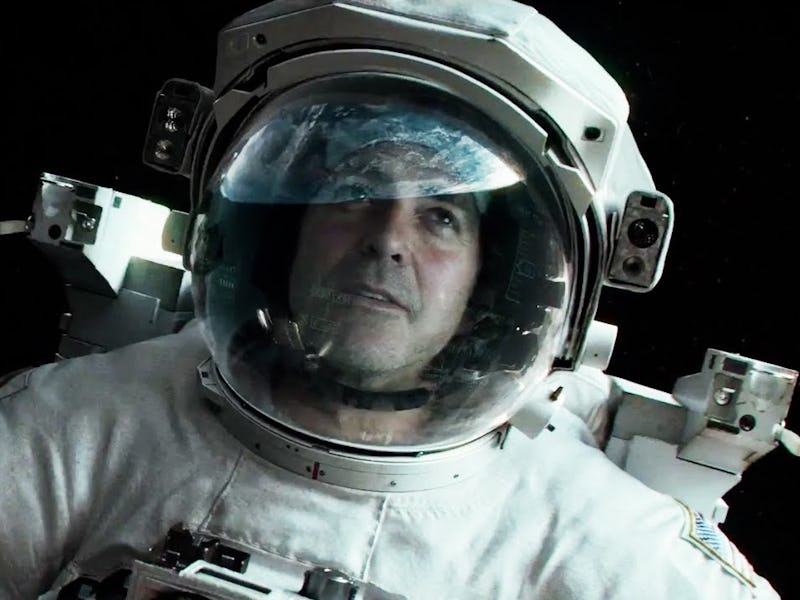You need to watch the most gripping sci-fi survival movie on HBO Max ASAP
Oodles of CGI can sometimes still tell a very human story.

There’s an old saying in the ever-growing space industry: space is hard. It’s used so often that in 2015 The Verge requested a moratorium, arguing that it “gives us a pass for our mistakes, like an adult comforting a toddler after a nasty fall.” But “space is hard” has continued forward, most recently seeing use in an advertisement for the burgeoning U.S Space Force.
The phrase has become a cliché, The Verge argues, “because of course spaceflight is hard.” Physics, engineering, and human psychology all collide together in conditions where there’s no room for error. It’s hard to imagine an environment more hostile to human life. But it’s one that provides a stunning background for Alfonso Cuarón’s 2013 movie Gravity, starring Sandra Bullock and George Clooney.
Cuarón makes space the perfect setting for a chase, just as Henri-Georges Clouzot found it in his 1953 classic The Wages of Fear, in which four desperate men drive trucks of explosive nitroglycerine over poorly maintained roads. But there’s a crucial difference. In Clouzot’s classic, men are forced to by oil companies and have very little say in their own survival. In Gravity, Bullock and Clooney have each other and a determination to live, if only until just the next moment.
Bullock plays Dr. Ryan Stone and Clooney plays Lt. Matt Kowalski, a perfectly mismatched pair. Stone is on her first mission, Kowalski his last as he prepares to be number two on the all-time “most hours in space” list. The mission is a routine job to perform a series of upgrades on the Hubble. Kowalski is relaxed, playing country music and telling old stories with Mission Control (Ed Harris). Stone is tense, considering that NASA hadn’t listened to her earlier suggestions. As a result, work is taking longer than expected.
Catastrophe strikes. Russia has destroyed one of its own satellites and the debris is hurtling towards them. What starts off as a suspicion quickly escalates into full-on catastrophe as the two are cut off from Mission Control and left to function on their own devices. This isolation starts off horribly, as Stone goes spinning out of control.
Seen here.
Cuarón’s great trick is making the non-scientific viewer realize how little they actually know about space. The burgeoning space tourism industry notwithstanding, zero-gravity will likely remain more of a concept than a reality for the vast majority of people watching Gravity. But as the name suggests, Cuarón makes the loss of that ever-present force feel staggering. Adrift in space and spinning, the viewer feels the claustrophobia of Stone’s suit.
Behind Gravity’s minimal cast was four years of technical work conducted by Cuarón and visual effects supervisor Tim Webber (both won Oscars), working with a crew of around 250. Webber estimates that around 80 percent of everything seen on screen in Gravity was CGI, compared to 60 percent of James Cameron’s Avatar.
But when StudioDaily asked Webber if he considered making the movie animated he declined, saying, “there’s something different about having a human performance. CG still can’t do humans absolutely believably. And this was a movie that had to not feel animated. It had to feel absolutely real.”
Bullock convincingly contemplated the universe while filming on set.
Much of that “real” feeling comes from Bullock, who described Gravity’s set to NPR as “basically a 9-by-9 LED box that was sort of on a platform.” Her performance, which earned her an Oscar nomination, is one of fear and isolation countered through knowledge and experience.
While Gravity was derided by some for not adhering to pure science, Cuarón realizes that beyond any technical abilities or scientific truths, his first priority is that of a storyteller. Gravity is ultimately a story of toughness, survival, and rebirth through adversity. Those simple concepts are pushed to their limits by the cast and crew, and the result is clearly one of the great movies of the 2010s.
Gravity is streaming on HBO Max.